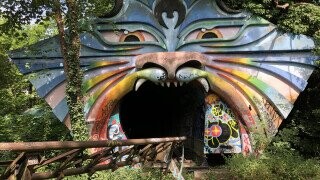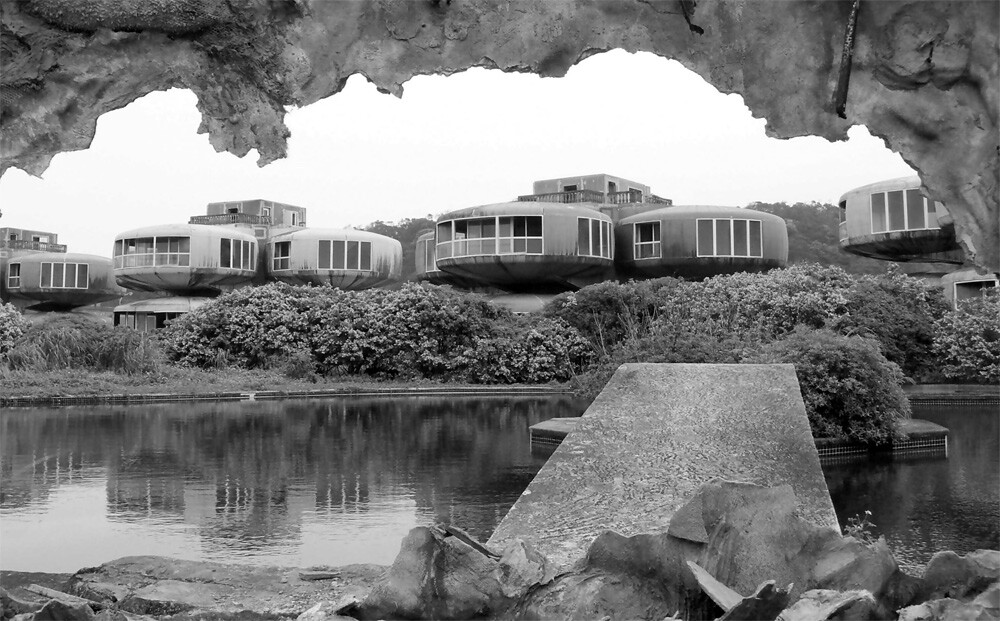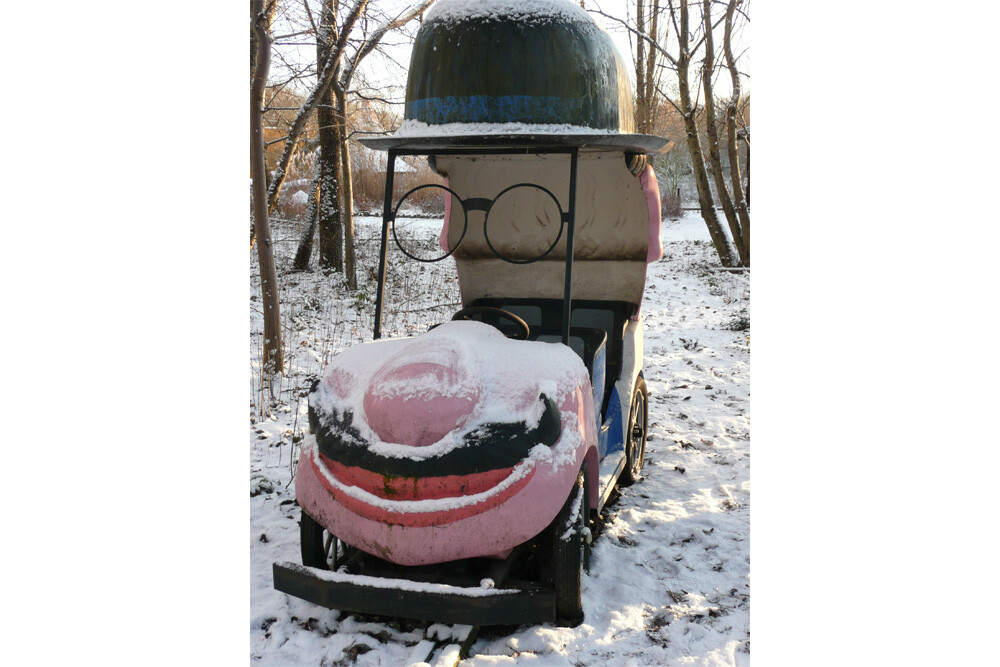5 True Stories About The World's Most Cursed Amusement Park

Every city has that one bizarre abandoned landmark, beloved by urban explorers and local needle enthusiasts alike. But lately, urban regeneration has claimed many of our most obviously cursed ruins. In Taiwan, for example, developers eventually demolished Sanzhi UFO City, a complex of futuristic living pods left to rot after a wave of mysterious suicides supposedly derailed construction. All Edinburgh mourns the loss of the Craigmillar Gulliver, a terrifying children's playground of crumbling concrete tunnels designed by an imprisoned murderer. And Los Angeles has been gradually removing the decaying remains of Murphy Ranch, the self-sustaining 1930s compound built by suspected Nazi sympathizers under the guidance of a mysterious German psychic.

But such losses pale in comparison to the work currently underway in Germany. It brings us absolutely no pleasure to report this, but the local government is finally redeveloping Spreepark, the abandoned communist amusement park slowly being reclaimed by the forest on the outskirts of Berlin. The city is planning to preserve a few Spreepark artifacts as part of a new cultural center, but it won't have the same magic. No cultural center is going to teach curious teens about the wonders of tetanus quite the way Spreepark did. So now might be the perfect time to take a look at the history of the park, featuring delusional Albanian kings, stolen roller coasters, tragic carousel accidents, and a surprising amount of cocaine.
Spreepark Was Berlin's Biggest Amusement Park ... Until It Was Hijacked To Peru
For many years, if you took Berlin's S-Bahn to Treptower Park, then continued south into the Planterwald, you would find yourself completely lost. But if you continued wandering around for another half hour, surviving on rainwater and berries, you might be lucky enough to reach a truly magical place. A mysterious wonderland of toppled dinosaur statues and mouldering merry-go-rounds, silently fading away into the trees. This was Spreepark, once the biggest amusement park in Berlin.

Back in 2002, humble Berliners woke up to the news that the park was gone. Not just out of business either, the best rides were literally hightailing it to Peru in a series of shipping containers. But what kind of Carnie Sandiego could hijack an entire theme park? Well, the mastermind was none other than the park's owner, Norbert Witte, who had been forced to declare bankruptcy after visitor numbers fell. Luckily, some guy he ran into mentioned that a theme park would definitely do great in Peru, so Norbert packed up six of his best rides and skipped town. He reportedly convinced authorities he was taking the rides for repairs, although we prefer to imagine a guy trying to clear airport security with an entire skycoaster taped underneath his shirt.

The rest of the park was simply abandoned, with a combination of legal wrangling and lack of interest from other tenants preventing the city from finding another use for the site. So poor Spreepark was left to decay, becoming one of Berlin's creepiest attractions in the process. By the way, if any of this is looking familiar it's because the climactic scenes of the 2011 movie Hanna were filmed in the park. Or possibly because that wolf tunnel appears in your dreams every night and whispers forbidden truths. One or the other!

The Bizarre Abandoned Communist Theme Park Problem In Eastern Europe
Spreepark was born back in the 1960s. The Berlin Wall had just gone up, and the East German government decided that the best way to cheer everyone up would be with a bunch of sweet Ferris wheels. This wasn't an unusual move—the whole Eastern Bloc was crazy for amusement parks. The Soviets were particularly big fans, and a city wasn't considered complete in the USSR without a bunch of zany rides at the edge of town. Even at the height of the 1930s Stalinist purges, work was underway on a 100-foot-tall spiral slide in Moscow. But Stalin had finally gone too far and a storm of public criticism erupted, claiming that the slide was far too safe and boring. So they just started letting people strap on parachutes and jump off the top.
After the fall of communism, a few of the parks managed to remain open, including one in Uzbekistan that rebranded as "Disneyland Tashkent" and serenely carried on operating until a few years ago, when Disney's copyright lawyers finally staged some kind of suicide charge on the Uzbek barricades and forced a name change. But many of the parks were simply abandoned, which is why decaying Soviet theme parks are a common sight from Lithuania to Abkhazia. Most of the attractions were mass produced at a factory in Russia, meaning you can stumble on a rusting old spinning ride in St. Petersburg, then travel 2,000 miles to Dilijan, Armenia and find the exact same ride about to be swallowed up by the forest. Seriously, if aliens ever land in the former Soviet Union they're going to assume humans recently conquered it in a devastating war with the Bumper Car people.

Over in Berlin, the newly united government was hoping to avoid a similar fate for Spreepark. And they had a pretty good shot! Despite its decadent capitalist ways, West Berlin had no amusement park worth mentioning, forcing humble West Berliners to amuse themselves as best they could in various nightclub bathrooms. And newly opened transport links promised a flood of wealthy Europeans, all screaming out for a ride on the finest Ferris wheels international communism ever produced. But to really appeal to cutting-edge Western tastes, officials knew that the park would need to be modernized. So they decided to lease it to an experienced entrepreneur with the capital and expertise to make it a success. Unfortunately, they couldn't really find anyone like that. Instead, they went with a married pair of funfair operators named Pia and Norbert Witte. And that's when things got really weird.
The King Of Albania's Grandson And Germany's Worst Carousel Crash
Norbert Witte quickly emerged as the mastermind of the new park, even though the whole thing was actually in his wife's name. That might be because Norbert had a bit of a checkered history when it came to rides, having single-handedly caused Germany's worst ever amusement park accident. In 1981, he was attempting to fix a malfunctioning roller coaster when the crane he was operating swung violently off course, slicing through the gondolas of a nearby carousel. Seven fairgoers died after falling 50 feet to the ground. Witte was ultimately convicted of negligent homicide. He served his time, but it's possible that "listen, I promise there won't be another mangling" caused some issues down at the insurance company.
But Norbert couldn't get out of the carnival business -- it was in his blood. His grandfather was none other than Otto Witte, who had joined the circus as a lion tamer at age eight and eventually worked his way up to King of Albania. According to Otto, he was working as a carnie at a travelling Balkan circus when he heard that the Albanians were in the market for a king to lead them to independence from the Ottoman Empire. By 1913, they had their heart set on the Sultan's nephew, who just happened to look identical to Otto himself. So why not replace an Ottoman with an Otto, man?

He quickly fired off a couple of telegrams announcing the prince's arrival and rode into the capital in a makeshift military uniform. The people promptly went mad with loyalty to their new king, while even the army joined him after he promised to lead them in a bloody attack on Serbia (Balkan politics became a little tense at some point in the Neolithic era and have failed to improve since). Otto's reign lasted for five days, at which point some very confused messages started flooding in from Istanbul. Now, the right move was obviously to wait for the real prince to show up, then stand in front of an empty mirror frame copying his every move. Instead, Witte helped himself to as much of the treasury as possible and hightailed it back to Germany, where he ran for president as leader of the "Party of Circus Performers."
Was Otto's story true? Well, in his defense, background checks for kings used to be terrible. In 1934, for instance, a Russian gigolo was hanging around Spanish yacht clubs trying to bang rich old ladies when he heard that the Andorrans were looking to achieve their own tiny independence. He raced up to the country in disguise as a wealthy count and managed to get officially appointed king before the Spanish cops arrived to expose his himbo shenanigans. And the Balkans do have a tradition of that kind of thing. Back in the 18th century, a local scammer apparently managed to get made ruler of Montenegro by impersonating Tsar Peter III of Russia, who was very dead at the time. By the time a delegation arrived from Russia to point this out, the Montenegrins had grown to like the imposter so much they decided to just keep him as leader anyway.
On the other hand, literally nobody in Albania remembers any suspiciously German kings. Plus Otto was a famous liar and the prince he was supposed to be impersonating never actually existed. So it definitely never happened. However, Otto spent the rest of his life claiming that it did, and proved so convincing that he managed to get a German identity card listing his occupation as "circus entertainer and one-time King of Albania." As a result, we can say that Otto was officially recognized as King of Albania—but only in Germany.
The Great Cocaine Carousel Caper
Norbert was raised to follow in his grandfather's footsteps and bought his first roller coaster at the age of 21 (he was trying to fix this same coaster when he caused the fatal crash). Spreepark was supposed to be the crowning achievement of his career. Under his supervision, the park was redesigned to feature a bunch of fiberglass dinosaurs and the very latest rides. But visitor numbers kept falling year after year until the park went bankrupt and the Wittes made their famous flight to Peru. Where things went from bad to worse.

As it turned out, Peruvians weren't exactly screaming out for a new theme park located back behind a local supermarket. To make matters worse, Peruvian customs held on to a bunch of key coaster parts, making it impossible to fully assemble any of the rides. And roller coasters are like vibrators, tons of fun under the right circumstances, but you really don't want to try jury-rigging one with stuff you find at a discount hardware store. Even the biggest coaster fan will generally back away after seeing one of the support struts is just a stack of phone books propped up on a chair. The Wittes wound up running out of money, barely able to afford food in their unwisely luxurious rented villa. And that's when the real trouble started.
In 2003, Witte shipped a ride called the Flying Carpet back to Germany, supposedly for repairs. Unfortunately, customs officials disassembled the ride and found the problems were most likely caused by the $14 million of cocaine stuffed inside one of the struts. That was a little higher than they were expecting the Flying Carpet to take them, and arrest warrants were quickly issued for Norbert and his son Marcel. Although we think they should have let it slide, if only because "The Flying Carpet: So Much Speed It'll Give You A Nosebleed!" is a great slogan, surpassed only by "The Flying Carpet: The Only Ride Where You Won't Complain About The Long Lines!"

The End Of Spreepark
Norbert WItte was arrested in Germany and served four years in prison for trafficking. His 21-year-old son Marcel wasn't as lucky. Arrested in Peru, he was sentenced to 20 years in the country's worst prison. Norbert's wife Pia, who was unaware of the cocaine plot, divorced him, saying she could never forgive him for recklessly ruining their son's life. After his release, Norbert wound up living in a caravan in the ruins of his beloved Spreepark, fending off thieves and vandals (including one guy who stole a swan boat and sailed it to a different state) and watching the park slowly decay and fade away. When Der Spiegel interviewed him in 2009, he was still dreaming of somehow buying a new ride and operating it one last time. It never happened. In 2014, a suspected arson attack burned down most of the remaining park buildings.
But things are changing. Marcel Witte returned to Germany in 2016, after enduring years of hell in the Peruvian prison system. According to Norbert, he immediately made a full apology to his son and they hugged, although things aren't quite the same. That same year, the government established a new state-owned company to redevelop Spreepark. Work is currently underway on turning the site into a public park and cultural center, which will incorporate many of the remaining Spreepark relics, including a "reimagined" version of the iconic Ferris wheel. So here's looking at you, Spreepark.

You can track Alex like a bloodhound on Twitter. You don't have to or anything, but you can.